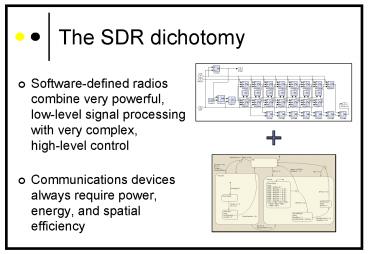The SDR dichotomy - PowerPoint PPT Presentation
1 / 9
Title:
The SDR dichotomy
Description:
Communications devices always require power, energy, and spatial efficiency ... Large, tiled structures can be tedious to deal with. Place and route is inherently slow ... – PowerPoint PPT presentation
Number of Views:31
Avg rating:3.0/5.0
Title: The SDR dichotomy
1
The SDR dichotomy
- Software-defined radios combine very powerful,
low-level signal processing with very
complex,high-level control - Communications devices always require power,
energy, and spatial efficiency
2
The critical tradeoffEase of design vs.
performance
- Industry consistently chooses software design for
the short turnaround time and learning curve - Software-based architectures are severely less
efficient than direct hardware mapping and work
poorly in real-time applications
3
The inefficiencies of software
- CPU power consumption scales with performance
- Limited ILP prevents parallel speedup
- Sequential architecture poorly utilizes area
- Caches will dominate die area around tiny core
4
The difficulties of hardware
- Mainstream hardware design involves synthesis of
HDL and routing of components - Synthesis can result in performance uncertainty
and requires a high level of skill - Place and route is an extremely long process
- HDL-based design must be at a farily low level of
abstraction to remain efficient - Algorithm designers often must pass designs on to
a hardware team for manual translation
5
The BEE 1.0 approach
- Designs entered graphically in Simulink and
Stateflow - Large, tiled structures can be tedious to deal
with - Place and route is inherently slow
- But mapping to hardware is clear
- Debugging is done within Simulink or with
ChipScope - Two debug phases, before and after hardware
implementation - Simulink is far too slow
- ChipScope requires a priori setup
6
Missing components of BEE
- A straightforward yet powerful programming model
with an efficient mapping to hardware - Rapid in-the-loop verification and debugging
directly on BEE - A quick and seamless model for accessing on-chip
resources from client workstations
7
Programming model
- Hybrid text/graphical description
- Exploit the objective nature of hardware
- Preserve a direct mapping to library blocks
- Expose performance tradeoffs and/or block
placement to the designer - Allow designer to choose text or graphical
formats at any level of the hierarchy - Several language options
- Build on top of Matlab (simpler to integrate with
existing BEE/Xilinx back-end flow) - Start with an OOP purists language like CLOS or
Smalltalk (risky, but more potential to radically
change the model) - Develop a completely new language (i.e.
Basis/Metavolt by Adam Megacz)
block MAC(in, out, sattrue) sig Ni new
fastvar(8, 2, 1)sig result m0 new mult(in,
Ni, sat)acc new add(m0.out, result.d,
sat)result acc.outout result.d
8
Debugging and monitoring
- Possibly the most attractive benefit of software
- Performed on same platform and at same speed as
final product - Need hardware equivalents of printf and gdb
- One for coarse testing and one for intense
cycle-by-cycle operation - Should help cope with the complexity of parallel
system state - Must play nice with existing implementation time
(long PR) - Minimize the need to rerun PR, until partial
reconfiguration and hardware-acceleration become
common
Design
Performance estimates?(future)
Compile(map, PR, etc.)
Verify andDebug
Maximize iterationswithin this stage
9
Hardware user interfaces
- A fundamental part of increasing the usability of
pure hardware systems is fast and simple access
to on-chip resources - Custom-designed hardware block communicates
between the running FPGA and the embedded Linux
for network access - Custom-made Matlab GUI provides direct data and
control features to on-chip designs before,
during, and after runtime






























